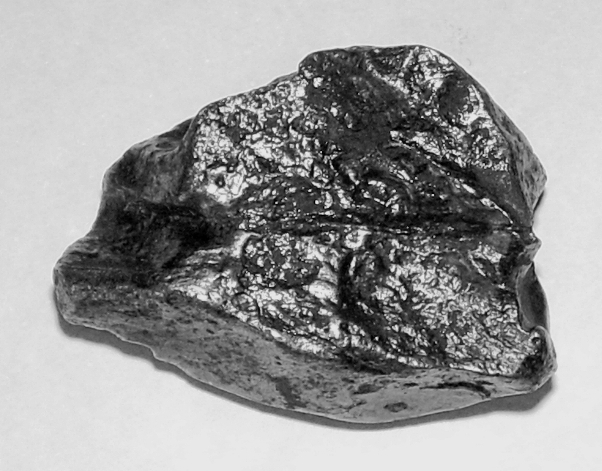Owning a piece of the early solar system
Since joining the UK Meteor Monitoring Network Project my interest in meteors, their compositions and origins is growing. Whilst tucked up in bed my CCTV camera scans the night sky looking out for tell-tale meteor trails and has already captured several hundred. What sets interest in meteors apart from other aspects of astronomy is that it is not just about observing something at a distance… a meteorite is something that you can feel and touch.
On a recent trip to Dublin I came across a dealer in rocks and minerals and decided to take a closer look. In one corner of his shop was a small selection of meteorites. It is rather enthralling holding in your hand something of non-terrestrial origin; material left over form the formation of our Solar System and which has travelled from the asteroid belt or perhaps from beyond. It was irresistible. The credit card was flexed, and I left the shop with fragments of the Sikhote-Alin and Muonionalusta meteorites weighing in at 45 and 34 grams respectively. Without delay I celebrated over a pint of Guinness and to my relief these two purchases solicited only one raised eyebrow from my wife.
Both of these meteorites have a rather interesting history.
Sikhote-Alin meteorite
The Sikhote-Alin meteorite, named after the mountain range in eastern Siberia, is one of the largest and most spectacular falls in recorded history. On February 12, 1947 eye-witnesses saw a large bolide, bright enough to cast shadows in broad daylight, travelling from the north. A bright flash and deafening explosion were observed as far away as 300 kilometers from the point of impact.
This was a massive meteorite fall. The overall size of Sikhote-Alin is now thought to have been over 100,000kg. The meteorite entered the atmosphere at a speed estimated to be around 14km/s and started to break apart. Fragmentation began at about 5.75km and the largest mass broke up in a violent explosion. The relatively low altitude gave little time for the fragments to disperse and the result was a very small area of strewn field. Estimates vary but some sources suggest that the strewn field covered 1.3 square km. According to the Montreal Planetarium web site most fragments have been recovered from an area just 100m by 600m. Some fragments caused impact craters the largest of which are up to 28m in diameter and 6m deep. From what is known from eye-witness reports and time of entry into the atmosphere the orbit of the Sikhote-Alin meteorite is believed to have been ellipse-shaped with its point of greatest distance from the Sun located in the asteroid belt.
The Sikhote-Alin meteorite is classed as ain iron meteorite composed of approximately 93% iron, 5.9& nickel, 0.46% phosphorus and 0.28% sulphur with trace amounts of germanium and iridium. Specimens of this meteorite are generally fall into one of two types:
- Individual, specimens – these are usually regmaglypted (thumbprinted), show fusion crust and signs of atmospheric ablation and probably broke off during the early descent
- Fragmented specimens: these are sharp edged shrapnel-like pieces of metal which show evidence of violent fragmentation having been torn off during atmospheric explosions or blasted apart on impact with the ground.
The largest fragment of Sikhote-Alin found to date weighs in at 1,745kg
Muonionalusta meteorite
The Muonionalusta meteorite is named after the municipality of Muonio located north of the arctic circle in the northern part of Sweden. The first Muonionalusta meteorite was discovered in 1906 by two children tending cattle and a second found in 1946 led to yet more discoveries. The
Muonionalusta meteorite is thought to be the oldest discovered meteorite impacting the Earth and is believed to be part of the iron core or mantle of a planetoid which shattered into many pieces as a result of its impact with Earth. With an estimated terrestrial age of over 800,000 years it was clear that the meteorite fragments must have carried into the area by the glaciers (Since landing here this meteorite has experienced four ice ages) but searches have so far found no evidence of a crater.
The Muonionalusta meteorite is classified as fine octahedrite. It is 8.4% nickel and trace amounts of rare elements with the remainder being Iron. More recent analysis has revealed the presence of stishovite, a form of quartz altered by extremely high pressure.
Widmanstätten patterns
My Muonionalusta meteorite had been cut, polished and etched to reveal a Widmanstätten pattern (also called a Thomson structure). Widmanstätten patterns, found in octahedrite iron meteorites, are formed by interwoven bands of kamacite and taenite, which can only form over literally millions of years of very slow cooling. These beautiful crystalline patterns tell us about the meteorites compositions and how long it took for the planetary core (from which a meteorite is derived) to cool. Larger crystals indicate slower cooling. The presence of the Widmanstätten pattern is proof of the extraterrestrial origin of the object.

A close up of the Widmanstätten pattern on the Muonionalusta meteorite Image credit Peter Campbell Burns
I was advised that Muonionalusta meteorite are less stable and therefore prone to more rapid oxidation. To keep the pattern looking its best an occasional coating of WD40 was recommended.
Where to buy
If you would like to own your own piece of the early solar system there are several UK suppliers which can be found on the internet, the two most interesting are:
- Space Rocks (www.spacerocksuk.com)
- UKGE (www.ukge.co.uk)
If you happen to be visiting Dublin I can recommend a trip to The Stone Gallery, Greystones.


